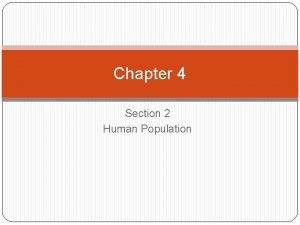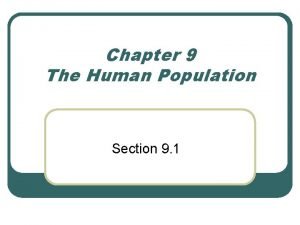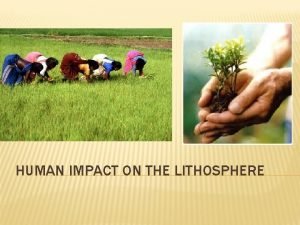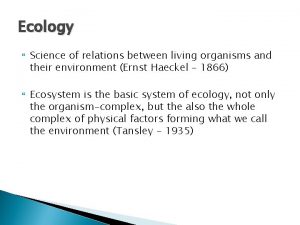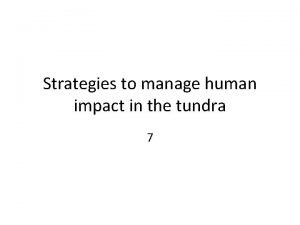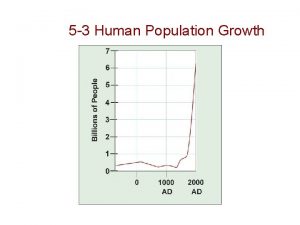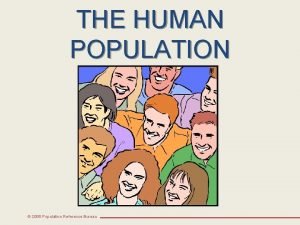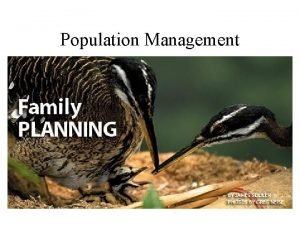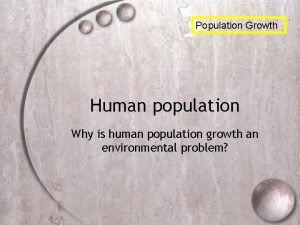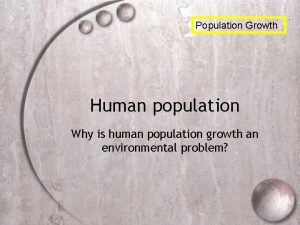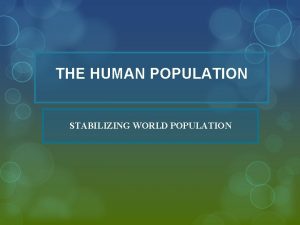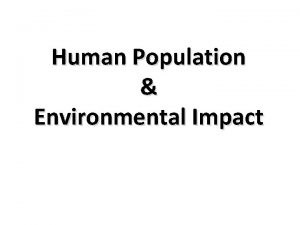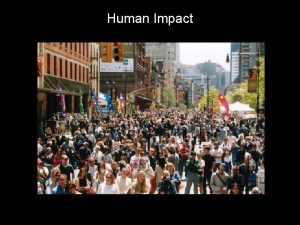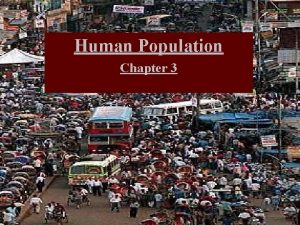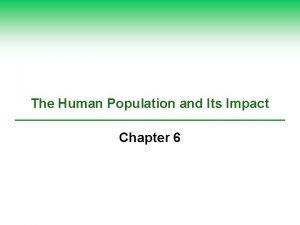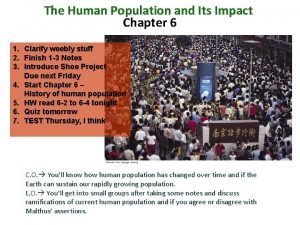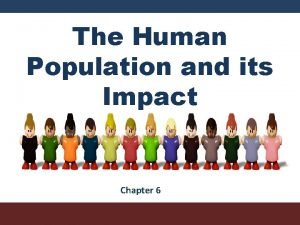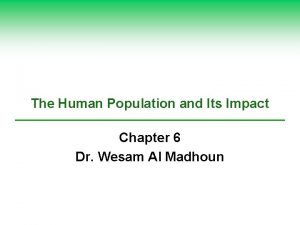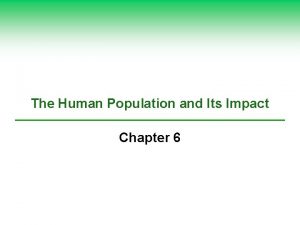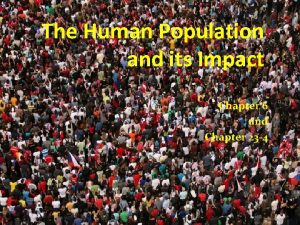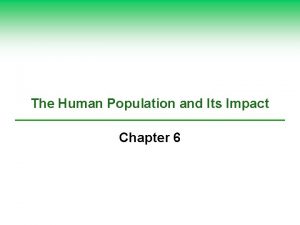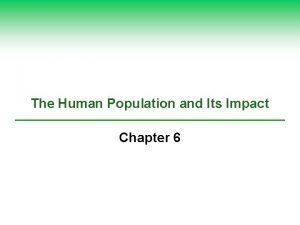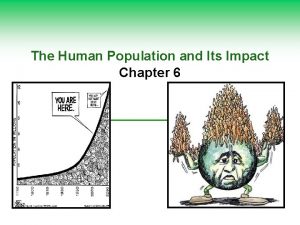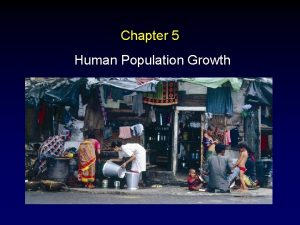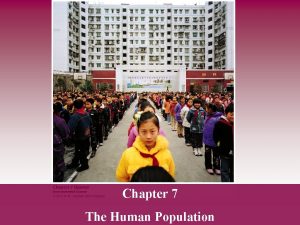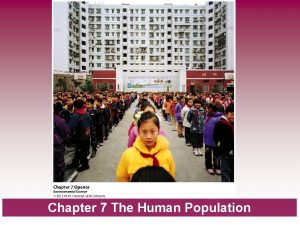Chapter 6 The Human Population and Its Impact


























































- Slides: 58

Chapter 6: The Human Population and Its Impact

Human Population Growth Continues but Is Unevenly Distributed In the past 200 years the human population has been growing exponentially (Jcurve). Three major factors of population growth: 1)ability of humans to expand into all of earths climate zones and habitats 2)emergence of modern agriculture allows us to produce more food 3)improvements in sanitation & health care and the development of antibiotics & vaccines have resulted in a drop of death rates

Core Case Study Slowing Population Growth In China: A Success Story China is the world’s most populated country with 1. 3 billion people Expected to reach 1. 5 billion by 2025 and decline to 1. 4 billion by 2050. Goal has been to sharply reduce the population using the One Child Policy – those who follow the policy receive benefits such as better housing , more food , and free health care Between 1972 and 2010, birth rates declined, trimming average number of children born to China’s women from 5. 7 to 1. 5

Core Case Study Slowing Population Growth In China: A Success Story China has undergone rapid industrialization- 100 million new people have created a middle class We should care about China’s population because: 1) We all depend on Earth’s life support systems to meet our basic needs for air, water, food, land, shelter, and energy. 2) Our current world population is not meeting the basic needs of 1. 4 billion people.

Slowing Population Growth in China: A Success Story China is the world’s most populous country, with 1. 3 billion people. In 1960, in order to avoid a serious threat of mass starvation due to a rapidly growing population, government officials established the world’s most extensive, intrusive, and strict family planning and birth control program. Their goal in this has been to sharply reduce population growth.


6 -1: How Many People Can The Earth Support? Human Population Growth Continues but is Unevenly Distributed Due to advances in technology, medicine, and modern agriculture, population has increased exponentially. Rate of population growth has slowed but the world’s population is still increasing exponentially at a rate of 1. 21% a year. 83 million new people added in 2010 – 1% added to MDC’s. Projected to be 7. 8 -10. 8 by 2050.

6 -1: How Many People Can The Earth Support? Human Population Growth Continues but is Unevenly Distributed Cultural Carrying Capacity is the maximum number of people that can live in a reasonable freedom and comfort indefinitely without decreasing the ability of the earth to sustain future generations.




6 -2 What Factors Influence the Size of the Human Population? The Human Population Can Grow , Decline, or Remain Fairly Stable • If there are more births than deaths during a given period of time, population increases. If reverse is true, then it decreases. • Crude birth rate is the number of live births per 1, 000 people in a population in a given year. • Crude death rate is the number of live deaths per 1, 000 people in a population in a given year. • Population change = (Births +Immigration) - (Deaths+ Emigration)

6 -2 What Factors Influence the Size of the Human Population? Women Are Having Fewer Babies but Not Few Enough to Stabilize the World’s Population Fertility rate is the number of children born to a woman during her lifetime. Replacement level fertility rate is the average number of children that couples in a population must bear to replace themselves (2. 1 in more developed countries and 2. 5 in less developed countries). Total fertility rate is the average number of children born to women in a population during their reproductive years.


6 -2 What Factors Influence the Size of the Human Population? Several Factors Affect Birth Rates and Fertility Rates Factors affecting birth rates and fertility rates include: Importance of children as part of the labor force Cost of raising and educating children. Availability of , or lack of, private and public pension systems Urbanization Educational and employment opportunities available for women Average of marriage Availability of legal abortions/ birth control.



6 -2 What Factors Influence the Size of the Human Population? Several Factors Affect Death Rates • Rapid growth of the worlds population over the past 100 years is not primarily due to higher birth rates but instead lower death rates. • Life expectancy is the average number of years a newborn infant can be expected to live. • Infant Mortality Rate is the number of infants out of every 1000 born who die before their first birthday. • Infant mortality rates have declined dramatically since 1965.

6 -2 What Factors Influence the Size of the Human Population? Several Factors Affect Death Rates Child mortality rates are the annual number of deaths among children under 5 per 1000 live births. The USA has the world’s highest teenage pregnancy rate. Child mortality varies greatly from region to region. According to the United Nations, the world’s child mortality rate dropped 20% between 1960’s and 2008.


6 -2 What Factors Influence the Size of the Human Population? Migration Affects an Area’s Population Size Migration is the movement of people into (immigration) and out of (emigration) specific geographic areas. Most people migrating from one area or country to another seek jobs and economic improvement. Religious persecution, ethnic conflicts, political oppression, wars, environmental degradation are also reasons people migrate.

Migration Affects an Area’s Population Migration: the movement of people into and out of specific geographic areas. Most people migrate seeking jobs and economic improvement. Religious persecution, ethnic conflicts, political

6 -3 How Does a Population’s Age Structure Affect Its Growth or Decline? A Population’s Age Structure Helps Us to Make Projections • Age Structure is the number or percentages of males and females in the young middle, and older age groups in that population. • The population age structure diagram is constructed by plotting a given population’s percentages of males and females in each of three age categories; pre-reproductive (0 -14), reproductive(15 -44), and postreproductive(45+).

6 -3 How Does a Population’s Age Structure Affect Its Growth or Decline? A Population’s Age Structure Helps Us to Make Projections • A country with a large percentage of its people younger than 15 will experience a rapid population growth. • Demographic momentum is the number of births that will rise for several decades even if women have an average of just 1 -2 children, due to a large number of girls entering their prime reproductive years.



6 -3 How Does a Population’s Age Structure Affect Its Growth or Decline? Populations Made Up of Mostly Older People Can Decline Rapidly Japan has the highest percentage of elderly people. With a population of 127 million in 2010, it is projected to shrink to 95 million by 2050. China’s One Child Policy means less children by 2020 - 31% of population 60+ years old.

6 -3 How Does a Population’s Age Structure Affect Its Growth or Decline? Populations Made Up of Mostly Older People Can Decline Rapidly Having a graying population leads to a declining work force, limited funds for supporting continued economic development, and fewer children and grandchildren to take care of the growing number of elderly people. Economic and social problems result from the rapid population decline - this can threaten population growth and create labor shortages.


6 -3 How Does a Population’s Age Structure Affect Its Growth or Decline? Populations Can Decline Due to a Rising Death Rate: The AIDS Tragedy • Between 1981 and 2009, AIDS killed more than 27 million people and takes about 2 million more lives each year. • AIDS kills many young adults ands leaves many children orphaned. • Results in drop in average expectancy, loss of productive young adult workers and trained personnel, and drastic change to a country's age structure. • Experts call for the international community to create and fund a massive program to help countries ravaged by AIDS. The program would reduce the spread of HIV by providing financial assistance for improving education and health care and providing social workers to try to compensate for the missing young-adult generation.


6 -4 How Can We Slow Human Population Growth? The First Step Is to Promote Economic Development The Demographic Transition states that as countries become industrialized and economically developed, first their death rates decline and then their birth rates decline. It takes place in 4 stages. The three most important steps: 1) Reduce poverty primarily through economic development and universal primary education 2) Elevate the status of women 3) Encourage family planning and reproductive health care

6 -4 How Can We Slow Human Population Growth? The First Step Is to Promote Economic Development Some analysts believe that most lesser developed countries will make a demographic transition over the next few decades Other analysts fear that rapid population growth, extreme poverty, and increasing environmental degradation in some low income, lesser developed countries will leave them stuck in stage two.




6 -4 How Can We Slow Human Population Growth? Empowering Women Helps to Slow Population Growth Women tend to have fewer children if they are educated, have the ability to control their own fertility, earn an income of their own, and live in societies that do not suppress their rights. Although women make up roughly half the world’s population, in most societies they have fewer rights, education, and economic opportunities than men.


6 -4 How Can We Slow Human Population Growth? The First Step Is to Promote Economic Development Globally, women account for 2/3 of all work done but receive only 10% of the world’s income. Women own less than 2% of the world’s land Women make up more than 70% of the world’s poor and 64% of its 800 million illiterate adults

6 -4 How Can We Slow Human Population Growth? Promote Family Planning Family planning provides educational and clinical services that help couples choose how many children to have and when to have them Family planning has been a major factor in reducing the number of births throughout most of the world, the number of abortions performed each year, and the number of mothers and fetuses dying during pregnancy. Responsible for a drop of 55% in total fertility rates in lesser developed countries.

6 -4 How Can We Slow Human Population Growth? Promote Family Planning Family planning also has financial benefits; studies show that each dollar spent on family planning saves $10 -16 in health, education, and social service costs. The United Nations Population Fund reports that 42% of pregnancies in lesser developed countries are unplanned and 26% end with abortion

Case Study: The U. S Population is Growing Rapidly The period of high birth rates between 1946 and 1964 is known as the baby boom. During the baby boom 79 million people were added to the US population. The drop of the total fertility rate has slowed the rate of population growth in the US , but the population is still growing faster than China's population. The leading causes of deaths in the US in 1907 were pneumonia, tuberculosis and diarrhea.



Case Study: The United States: A Nation of Immigrants • Currently, legal and illegal immigration accounts for about 36% of the country’s annual population growth. • Latin Americans make up 53% of our immigrants, Asians makes up 25%, and Europeans makes up 14% • There are many debates of whether to reduce legal immigration in the US. • 60% of the American public supports reducing legal immigration.

Case Study: The United States: A Nation of Immigrants Some argue that it would diminish the United states historical role of the land of opportunity to limit immigration, taking away from the world’s cultural diversity. Immigrants open up businesses and they help the US succeed in the global economy. Many immigrants take menial and low paying jobs that Americans shun.


Case Study: The American Baby Boom The baby boom added 79 million more people to the US population. Baby boomers created the youth market in their teens and twenties. Due to the downturn in the economy in 2007, many of these baby boomers lost their jobs and much of their savings. In 1960, 1: 11 Americans were 65+. This number will grow sharply through 2030. This is called the graying of America.


Case Study: Slowing Population Growth in India In 1952, India added 5 million people to its population. In 2010, it added 18 million. 32% of India’s population is under the age of 15. India has the world’s largest economy and is thriving, but it faces serious poverty and malnutrition.

Case Study: Slowing Population Growth in India • Indian women have an average of 2. 6 children. • They believe that they need more children to work and care for them in old age. • Like China, India has many critical environmental problems. • They only have 2. 3% of the world’s land resources and 2% of its forests • More than 2/3 of its water is seriously polluted and they also have serious air pollution.


Science Focus: Projecting Population Change There are countless factors that demographers have to consider when making population projections They have to determine the reliability of current population estimates, estimate trends in fertility, and consider that different organizations use different sets of data and differing methods to make projections. All these factors make for a variation of projections


Science Focus: How Long Can the Human Population Keep Growing? Human activities have directly affected 83% of the earth’s land surface, excluding Antarctica. Thomas Malthus hypothesized that the human population tends to increase exponentially while food supplies tend to increase more slowly at a linear rate. However, because of technological advances in food production, food has also increased exponentially.

Science Focus: How Long Can the Human Population Keep Growing? Overconsumption and overpopulation are considered the key problems At today’s level of consumption, scientists estimate that we would need the equivalent of 1. 3 planet Earths to sustain our per capita use of renewable resources indefinitely. By 2050, with the projected population increase, we will likely need almost 2 planet Earths to meet such resource needs and 5 Earths if everyone reaches the current U. S level of renewable resource consumption person

Science Focus: How Long Can the Human Population Keep Growing? Some analysts believe that because of our technological ingenuity, there are few, if any, limits to human population growth and resource use person Most agree that we have used technology to alter natural systems to meet our growing needs and wants

 Chapter 4 section 1 population dynamics
Chapter 4 section 1 population dynamics Chapter 4 population dynamics study guide answers
Chapter 4 population dynamics study guide answers Chapter 27 human impact on earth resources
Chapter 27 human impact on earth resources Chapter 16: human impact on ecosystems answer key
Chapter 16: human impact on ecosystems answer key Chapter 16 human impact on ecosystems
Chapter 16 human impact on ecosystems Characteristics of renaissance
Characteristics of renaissance Lesson 5 the slave trade and its impact on africa
Lesson 5 the slave trade and its impact on africa Chapter 4 section 2 human population answer key
Chapter 4 section 2 human population answer key Chapter 4 section 1 population dynamics answer key
Chapter 4 section 1 population dynamics answer key Chapter 9 the human population section 1
Chapter 9 the human population section 1 Section 1 population dynamics answer key
Section 1 population dynamics answer key Population ecology section 1 population dynamics
Population ecology section 1 population dynamics Human needs and human development
Human needs and human development Chapter 8 human needs and human development
Chapter 8 human needs and human development Emigree structure
Emigree structure Its halloween its halloween the moon is full and bright
Its halloween its halloween the moon is full and bright Human movement impact factor
Human movement impact factor Biome ex
Biome ex How do humans impact the lithosphere
How do humans impact the lithosphere Human impact on agriculture
Human impact on agriculture Human impact on the phosphorus cycle
Human impact on the phosphorus cycle Human impact on terrestrial ecosystems
Human impact on terrestrial ecosystems How are deserts formed
How are deserts formed Human impact in the tundra
Human impact in the tundra Human impact on beaches
Human impact on beaches Human impact on groundwater
Human impact on groundwater Human impact on freshwater ecosystems
Human impact on freshwater ecosystems Human impact on oceans
Human impact on oceans Drilling for oil and gas can interrupt migration in
Drilling for oil and gas can interrupt migration in Whats a density dependent factor
Whats a density dependent factor Section 5-3 human population growth
Section 5-3 human population growth Human population
Human population Humandesignblueprint
Humandesignblueprint Eugenic population policies definition ap human geography
Eugenic population policies definition ap human geography Minimum viable population
Minimum viable population When a train increases its velocity, its momentum
When a train increases its velocity, its momentum Sunny rainy cloudy windy stormy
Sunny rainy cloudy windy stormy If its square its a sonnet summary
If its square its a sonnet summary Its not easy but its worth it
Its not easy but its worth it Hát kết hợp bộ gõ cơ thể
Hát kết hợp bộ gõ cơ thể Lp html
Lp html Bổ thể
Bổ thể Tỉ lệ cơ thể trẻ em
Tỉ lệ cơ thể trẻ em Voi kéo gỗ như thế nào
Voi kéo gỗ như thế nào Tư thế worm breton là gì
Tư thế worm breton là gì Chúa sống lại
Chúa sống lại Các môn thể thao bắt đầu bằng tiếng chạy
Các môn thể thao bắt đầu bằng tiếng chạy Thế nào là hệ số cao nhất
Thế nào là hệ số cao nhất Các châu lục và đại dương trên thế giới
Các châu lục và đại dương trên thế giới Công thức tiính động năng
Công thức tiính động năng Trời xanh đây là của chúng ta thể thơ
Trời xanh đây là của chúng ta thể thơ Mật thư anh em như thể tay chân
Mật thư anh em như thể tay chân Phép trừ bù
Phép trừ bù Phản ứng thế ankan
Phản ứng thế ankan Các châu lục và đại dương trên thế giới
Các châu lục và đại dương trên thế giới Thơ thất ngôn tứ tuyệt đường luật
Thơ thất ngôn tứ tuyệt đường luật Quá trình desamine hóa có thể tạo ra
Quá trình desamine hóa có thể tạo ra Một số thể thơ truyền thống
Một số thể thơ truyền thống Cái miệng nó xinh thế
Cái miệng nó xinh thế







